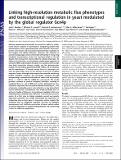| dc.contributor.author | Moxley, Joel F. | |
| dc.contributor.author | Jewett, Michael C. | |
| dc.contributor.author | Antoniewicz, Maciek R. | |
| dc.contributor.author | Villas-Boas, Silas G. | |
| dc.contributor.author | Alper, Hal | |
| dc.contributor.author | Wheeler, Robert T. | |
| dc.contributor.author | Tong, Lily V. | |
| dc.contributor.author | Hinnebusch, Alan G. | |
| dc.contributor.author | Ideker, Trey | |
| dc.contributor.author | Nielsen, Jens Kromann | |
| dc.contributor.author | Stephanopoulos, Gregory | |
| dc.date.accessioned | 2009-12-28T16:10:44Z | |
| dc.date.available | 2009-12-28T16:10:44Z | |
| dc.date.issued | 2009-04 | |
| dc.date.submitted | 2008-11 | |
| dc.identifier.issn | 0027-8424 | |
| dc.identifier.uri | http://hdl.handle.net/1721.1/50252 | |
| dc.description.abstract | Genome sequencing dramatically increased our ability to understand cellular response to perturbation. Integrating system-wide measurements such as gene expression with networks of protein–protein interactions and transcription factor binding revealed critical insights into cellular behavior. However, the potential of systems biology approaches is limited by difficulties in integrating metabolic measurements across the functional levels of the cell despite their being most closely linked to cellular phenotype. To address this limitation, we developed a model-based approach to correlate mRNA and metabolic flux data that combines information from both interaction network models and flux determination models. We started by quantifying 5,764 mRNAs, 54 metabolites, and 83 experimental 13C-based reaction fluxes in continuous cultures of yeast under stress in the absence or presence of global regulator Gcn4p. Although mRNA expression alone did not directly predict metabolic response, this correlation improved through incorporating a network-based model of amino acid biosynthesis (from r = 0.07 to 0.80 for mRNA-flux agreement). The model provides evidence of general biological principles: rewiring of metabolic flux (i.e., use of different reaction pathways) by transcriptional regulation and metabolite interaction density (i.e., level of pairwise metabolite-protein interactions) as a key biosynthetic control determinant. Furthermore, this model predicted flux rewiring in studies of follow-on transcriptional regulators that were experimentally validated with additional 13C-based flux measurements. As a first step in linking metabolic control and genetic regulatory networks, this model underscores the importance of integrating diverse data types in large-scale cellular models. We anticipate that an integrated approach focusing on metabolic measurements will facilitate construction of more realistic models of cellular regulation for understanding diseases and constructing strains for industrial applications. | en |
| dc.description.sponsorship | National Center for Research Resources | en |
| dc.description.sponsorship | Singapore–Massachusetts Institute of Technology Alliance | en |
| dc.description.sponsorship | National Science Foundation International Research Fellowship Program | en |
| dc.description.sponsorship | National Institutes of Health | en |
| dc.language.iso | en_US | |
| dc.publisher | National Academy of Sciences | en |
| dc.relation.isversionof | http://dx.doi.org/10.1073/pnas.0811091106 | en |
| dc.rights | Article is made available in accordance with the publisher's policy and may be subject to US copyright law. Please refer to the publisher's site for terms of use. | en |
| dc.source | PNAS | en |
| dc.title | Linking high-resolution metabolic flux phenotypes and transcriptional regulation in yeast modulated by the global regulator Gcn4p | en |
| dc.type | Article | en |
| dc.identifier.citation | Moxley, Joel F et al. “Linking high-resolution metabolic flux phenotypes and transcriptional regulation in yeast modulated by the global regulator Gcn4p.” Proceedings of the National Academy of Sciences 106.16 (2009): 6477-6482. | en |
| dc.contributor.department | Massachusetts Institute of Technology. Department of Chemical Engineering | en_US |
| dc.contributor.department | Whitehead Institute for Biomedical Research | en_US |
| dc.contributor.approver | Stephanopoulos, Gregory | |
| dc.contributor.mitauthor | Moxley, Joel F. | |
| dc.contributor.mitauthor | Antoniewicz, Maciek R. | |
| dc.contributor.mitauthor | Alper, Hal | |
| dc.contributor.mitauthor | Tong, Lily V. | |
| dc.contributor.mitauthor | Stephanopoulos, Gregory | |
| dc.relation.journal | Proceedings of the National Academy of Sciences of the United States of America | en |
| dc.eprint.version | Final published version | en |
| dc.identifier.pmid | 19346491 | |
| dc.type.uri | http://purl.org/eprint/type/JournalArticle | en |
| eprint.status | http://purl.org/eprint/status/PeerReviewed | en |
| eprint.grantNumber | 018627 | en |
| eprint.grantNumber | 1R01 DK075850-01 | en |
| dspace.orderedauthors | Moxley, J. F.; Jewett, M. C.; Antoniewicz, M. R.; Villas-Boas, S. G.; Alper, H.; Wheeler, R. T.; Tong, L.; Hinnebusch, A. G.; Ideker, T.; Nielsen, J.; Stephanopoulos, G. | en |
| dc.identifier.orcid | https://orcid.org/0000-0001-6909-4568 | |
| mit.license | PUBLISHER_POLICY | en |
| mit.metadata.status | Complete | |
